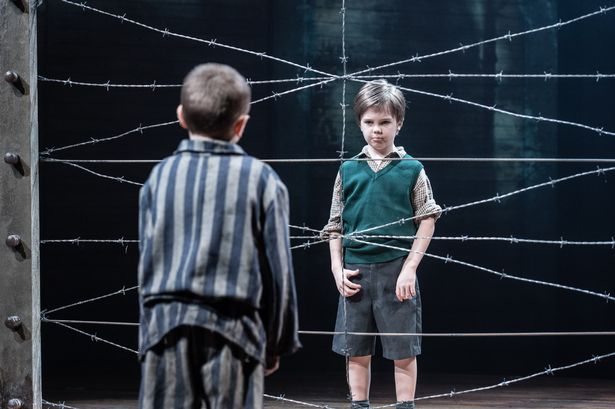Review: ‘The Boy in the Striped Pyjamas’
There is a certain expectation when it comes to theatre adaptations of well-known books. This could be seen as the case with Angus Jackson’s adaptation of John Boyne’s ‘The Boy in the Striped Pyjamas’ – a book critically acclaimed in its own right, selling more than five million copies and reaching number one on the New York Times bestseller list. Boyne’s novel shows the holocaust through the opposing eyes of a privileged German boy and a malnourished Polish Jew; two boys with the same birthday but from very different sides of the fence. With a bare exposed brick and metal back drop and a circular wooden platform where the action took place, Jackson perfectly captured the feeling of the difficult time by focusing on symbolic props and the use of words visually, but most importantly the experiences and interactions of Bruno and Shmuel.
The play, presented by the Children’s Touring Partnership, relies on boys as young as 9 to carry the whole performance. Perhaps more demanding than the film adaptation of ‘The Boy in the Striped Pyjamas’ directed by Mark Herman, the theatre production required a succinct 2 hours where the lead, Bruno, was only able to leave the stage briefly. An impressive feat for someone not even out of primary school. Using accurately aged actors provided poignancy, as from the mouths of these young talents came evocative lines such as “he makes me feel cold”, “Poland, that’s not as good as Germany is it?” and “why are they all wearing striped pyjamas?” The audience is enveloped by the world of the children, while simultaneously listening in on the adult conversations and seeing the significance of details Bruno doesn’t quite understand. The play does rely on some prior historical knowledge to fill in the gaps, as we can assume “Out-with” is really “Auschwitz” and “The Fury” as “The Fuhrer”.
The director, Joe Murphy, seems to have been heavily influenced by the Epic theatre tradition through the use of the bare stage with minimal props such as the window Bruno stares out of, his father’s desk and of course, the symbolic fence. The barbed wire and metal panel remains centre stage during the interval, almost serving as a reminder as we buy our ice-cream that the division still remains.
The book itself is heavily integrated into the performance, with chapter titles appearing on the back wall of the stage, giving us some expectation and thus numbing our emotional attachment. As “thinking up the final adventure” flashes, the connection to Hitler’s ‘final solution’ is apparent. Regardless of the devices used to offer the story up as an example, it is difficult not become involved in the drama and to feel the echo of the closing chamber door deep within your stomach.
The play begins with the narrator announcing, “this is a fable” and ends “It was a long time ago. Nothing like that could ever happen again, not in this day and age”. The final note is uneasy, with the moral lesson of the tale glaring. Though it tries hard to underline the fictional elements, everything just feels all too familiar.
We see the contrast of the Germans to the Jewish, of Bruno’s crisp green jumper to Shmuel’s dirty uniform. Grandmother’s theory of “wear the right outfit and you feel like the person you’re pretending to be” seems oddly significant, supported by the strong costume design that reflects the clothing of the period. Suddenly the imposing Nazi uniforms are exposed as costumes themselves, perhaps prompting the idea that maybe they are just pretending, wearing an outfit and becoming what it expects. The horrors of the holocaust become just a children’s game of pretend gone too far.
We see Bruno and Shmuel’s relationship develop like any other, but in the unlikeliest of places. In his final line, Bruno declares them “best friends for life” moments before the chamber doors shut. The message is simple – if these two can get along, why do the adults find it so difficult?

Comments (2)
hi good blog is amazing!
PPD Website http://www.dolcefiles.net